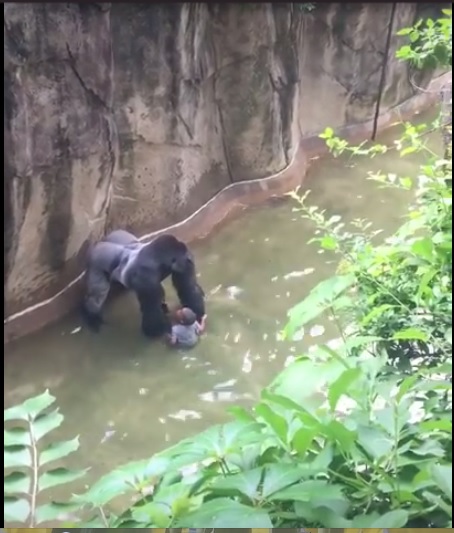
By now you’ve probably heard the story about Harambe, the 17 year old west lowland gorilla who was shot by zoo keepers at the Cincinnati Zoo after a small child fell into the gorilla enclosure. I caught bits and pieces of the story over the holiday weekend, but it wasn’t until this morning that I was able to devote some attention to the matter.
I finally saw the video.
Originally, I didn’t want to touch this story with a 10 foot pole, mostly because I didn’t think that I could add anything to the conversation, which was getting more emotionally charged by the minute. I get enough hate mail when I take people to task for not obeying the leash law.
Another reason is because it’s not a simple issue. Each thread you pull unravels another thread and another and another, and before you know it you’re pondering everything from what constitutes parental neglect to the ethics of zoos in general to the disappearing gorilla habitat. I didn’t feel like I could blast off a quick post and do the story justice.
Then I was asked to write about it and so here I am, pondering all of those issues, but mostly wondering what transpires between man and beast when they come face to face and only one can survive the encounter.
The two minute video I watched was disturbing, but I was also surprised that it wasn’t the violent, bloody footage I’d expected to see after hearing the news bites all weekend. It seemed the boy faced far more danger from drowning than being thrown about by a gorilla.
I kept going back, not to the screams of the crowd; not to the horror that poor mother surely suffered watching her child being dragged through the water; not to the split second decisions required by zoo staff about whether to tranquilize or kill the animal in what they deemed was a life threatening situation.
What I kept coming back to were the moments when Harambe and the boy were sitting quietly, the gorilla blocking the boy from view of the screaming spectators, the boy’s stunned gaze fixed firmly on the majestic beast, the two barely moving as they summed up the situation, small child who wanted to swim with the gorillas, gorilla unsure what to do with this small child who had dropped into his front yard.
Toddler-sized awe focused on 400-plus pounds of raw power. Wild animal gently touching tiny human.
Yes, there is horror and anger and uproar at what ensued, and a little boy is in the hospital and an endangered animal is dead. But there is also mystery and, if I can be so bold, a beauty at what did not happen.
A beast did not kill a child.
The majestic creature, who never asked to be put on display, encountered a wee toddler, who could not resist the temptation to breach the barrier.
I let myself imagine that, in the chaos and confusion of the humans above, perhaps for a moment or two in the gorilla enclosure below the world stopped for Harambe and the child, and nothing existed but boy and animal, life and death, an ending for one and a new beginning for the other, and for a few seconds neither knowing which would experience which.
As we know, in a “wild animal vs humans” showdown like this, when two lives are at stake and no one can predict the animal’s next move, a choice must be made and be made quickly. And the human survives.
The humans had caged an animal and deemed him dangerous, and then prepared for the scenario just like this, when he would come face to face with a defenseless human.
What choice did zoo keepers have? When the child breeched the barrier, zoo officials immediately called the gorillas out of the enclosure. The two females complied. Harambe chose to stay with the boy. Even if Harambe was acting without malice, which appears to be the case, his sheer size could have accidentally killed the child. Action must be swift and sure; no time to negotiate a hostage exchange.
The alternative would have been to leave the toddler in there and see whether the gorilla snuggled him or tore him from limb to limb. If there is a person out there who thinks that was an option, please direct your hate mail in his direction.
I prefer to imagine that Harambe took stock of the situation and understood the inevitable outcome. Perhaps, I imagine, he sheltered the boy so that he could speak to him, living spirit to living spirit, assuring the child that he would be all right, that help would come, but needing the time to impart some raw animal wisdom of the ages that the child could carry with him through life.
Because this small child would live to tell the story of how he had been touched by a gorilla.















